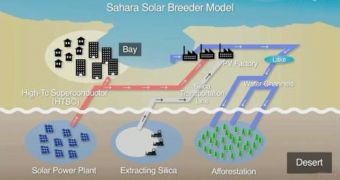The Sahara Solar Breeder Project is, apparently, one gigantic renewable energy project, and if you have not heard about it before, know that its goal is to power half of the globe by 2050.
The idea is to build a silicon manufacturing plant in the desert, and thanks to that silicon, to start building solar power plants nearby.
The next step will be to use some of the electricity generated by the solar power plants to build more silicon manufacturing plants, and maybe start the 'reign' of solar energy.
The project leader calls it the Super Apollo Project and its initial goals are to make this project viable.
There are a few certain obstacles that will need to be surpassed, like “frequent sandstorms, the need to use liquid nitrogen to cool cables and to bury them in the sand to minimize fluctuations in temperature”, and last but not least, the training of African engineers and scientists in research and development regarding this process.
The researchers will probably have a hard time achieving all of their technological goals, but as DigInfo TV writes, “in this initial project, it will be important to demonstrate the possibility of manufacturing high-purity silicon from desert sand and constructing a high-temperature superconducting, long-distance, DC power supply system.”
This titanesque project is a collaboration between universities in Algeria and Japan, and according to Clean Technica, the leader of the project is Hideomi Koinuma of the University of Tokyo.
“The energy generated by the solar power plants will be distributed as direct current via high-temperature superconductors, a process that Koinuma said will be more efficient than using alternating current,” writes PhysOrg.
“He envisages a large network of supercooled high-voltage direct current grids capable of transporting the expected 100 GW of electricity at least 500 kilometers.”
Koinuma explained that even though “the total research expenditure will be 100 million yen annually for five years, that won’t be enough to complete the project.
“Nevertheless, we want to establish basic technology for providing an ultimate solution to the energy problem, which must be done before a global crisis occurs.”
Watch the video presentation of the project:

 14 DAY TRIAL //
14 DAY TRIAL //